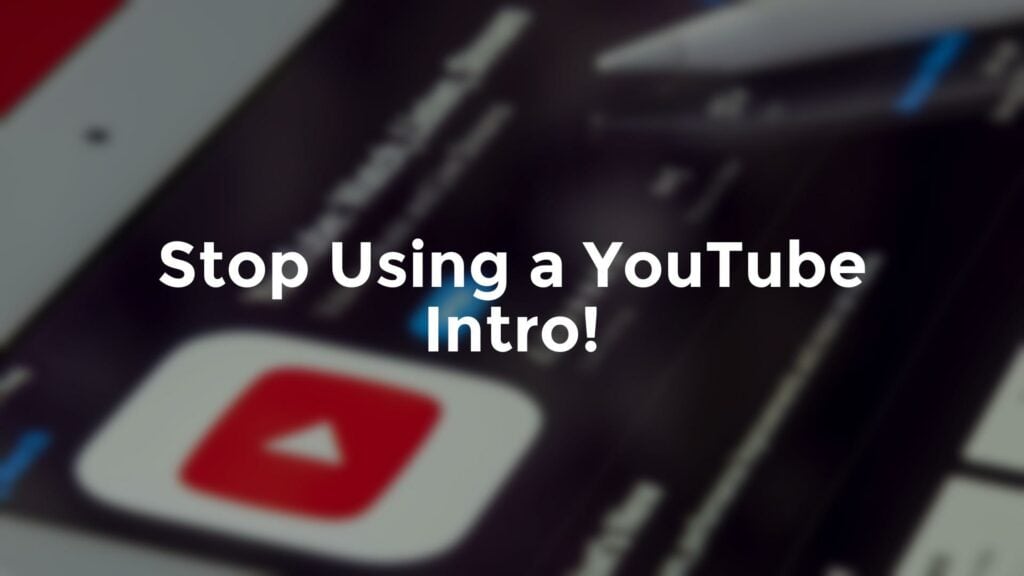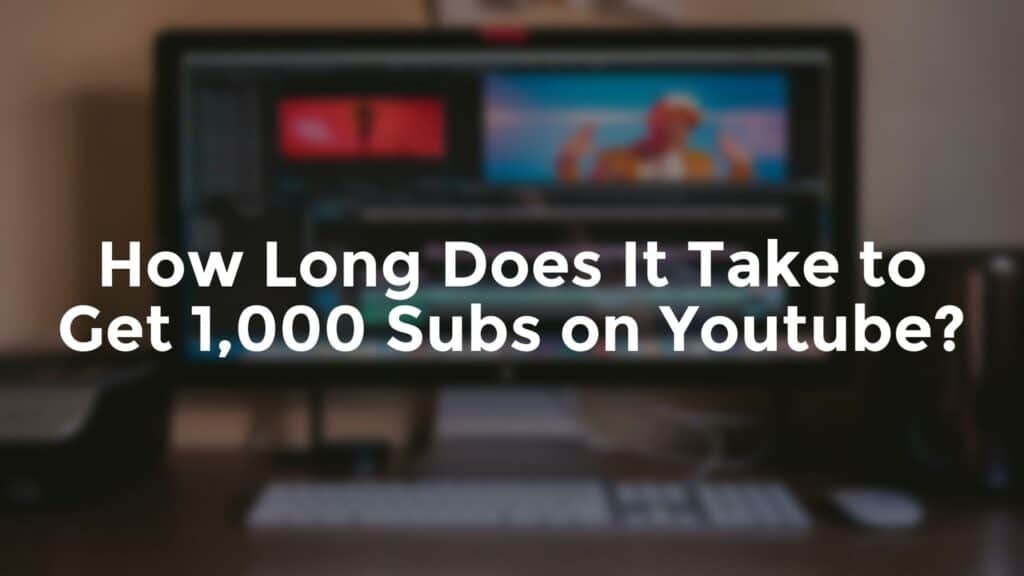Updated Jan 04, 2024
Whether you’re just starting out on YouTube, or you already have a (successful) channel, you’re probably wondering: “Should I have a YouTube intro”.
This question has actually a lot more implications than you might think, and the answer flies in the face of common sense.
Should You Have A YouTube Intro?
You shouldn’t have a YouTube intro. It delays the useful or entertaining part of your video with no added value for the viewers. Because most viewers skip YouTube intros, it makes your audience retention metric decrease. In turn, the YouTube algorithm could penalize your video by not showing it in the suggested videos or in search.
I know this answer is counterintuitive.
But it will make sense as soon as I explain why having a YouTube intro hurts your audience retention metric, and what you should do instead.
What Is A YouTube Intro
First and foremost: don’t confuse a YouTube video intro with a channel introduction video!
These are 2 different things.
- An intro is a video clip of a few seconds, mostly with a music background and sometimes sound effects. It consists of animated images or very short clips and typically runs for 3 to 30 seconds at the beginning (or in the first part) of YouTube video.
- On the other hand, a channel introduction video is a video explaining what a channel is about. It’s featured at the top of a channel page and encourages people to subscribe to a channel.
However, more and more YouTube creators use the featured video to showcase their best content, and attract viewers to stick around (or even subscribe).
While it’s totally fine to use a channel introduction (or even better: your best content) as a featured video on your YouTube channel, you don’t need to make a YouTube intro.
Actually, you don’t want to make one.
But don’t take my word for it!
Why Did Game Theory Stop Using the Intro?
Game Theory, the YouTube channel with a whopping 18.3 million subscribers (as of Jan 2024), made a big change!
No more traditional intro.
Why? Because we all love getting right to the good stuff, just like on TikTok or with creators like MrBeast.
MatPat from Game Theory shared all about this in a video. He talked about how the viewers now prefer to dive straight into the main message.
Remember the ‘Science Blaster’ intro? It was cool, but times are changing. People want content fast and direct.
Now, Game Theory’s intros are quick and match the episode’s vibe. Spooky theme for a horror game or a Marvel-like style for a film theory episode – it’s all about keeping up with what we love.
It’s a smart move, showing us how important it is to stay fresh and engaging in the world of digital content.
If MrBeast Doesn’t Use Intros, Why Would You?
Ever wondered how MrBeast instantly hooks us in his videos? He skips the usual intro routine and dives right into the heart of the action with quick, snappy editing and bold, eye-catching text.
It’s like he’s inviting us on an adventure from the very first second.
His videos are a rollercoaster from start to finish. He’s known for his incredible, sometimes outrageous challenges. Titles like “I Spent 7 Days Buried Alive” or “Last To Take Hand Off Jet, Keeps It!” spark our curiosity instantly. These hooks are filled with suspense and thrill.

And the way he edits?
It’s like a fast-paced dance, keeping our eyes glued to the screen. There’s never a chance to get bored. Each cut, each scene is designed to keep the excitement going.
Plus: huge stacks of cash, breathtaking locations, and unique, sometimes bizarre items add an extra layer of wow. It’s not just about what you hear; it’s also what you see that makes his content so engaging.
MrBeast knows the secret sauce to keeping us entertained. And it starts by not having an intro!
Why You Shouldn’t Have a YouTube Intro
The most common reason people have an intro is because they think it’s a way to show off their creativity or make your channel look professional, especially if you’re just starting out.
But the reality is, YouTube intros don’t bring any value to your audience or your channel.
- They annoy the viewers – they have to wait to get to the actual content.
- They decrease your audience retention metric – the average viewer will have already left by the time your intro is over.
- They make your videos less likely to be recommended – YouTube will see that the average viewer leaves before the interesting part of the starts, and will rank your video lower in the search results, or not recommend it as much
- They decrease your CTR (click-through rate) and watch time – if your video is ranked lower in the search results, it will get fewer clicks and fewer views.
- They decrease your revenue – that’s pretty straightforward: fewer views, less money
Now, you probably think you need to make an intro to become a successful YouTuber. But the truth is no YouTube intro maker will help you get there – never has, never will.
Let me say this again, just to make it crystal-clear: you don’t need a YouTube intro.
- Using a template doesn’t make any channel cooler or more entertaining – good content does
- A YouTube intro doesn’t make for a great brand – a clear purpose, value proposition and fair pricing does
- Big YouTubers didn’t get big because they have an intro – they did because they post good content, again and again
Getting more views (the ultimate goal for your channel) has nothing to do with having a great YouTube intro.
But seriously, are YouTube intros THAT bad?
Don’t take my word for it…
Intros Hurt Your Audience Retention Metrics
YouTube intros won’t help you grow a successful channel, but they will actually hurt one of your most important engagement metrics: audience retention.
What is Audience Retention? Audience retention, also called “average percentage viewed’ is the average percentage of the video that viewers watch. It’s one of the metrics YouTube uses to rank videos in the search results and suggest it to viewers.
Let’s take a 5-minute video as an example:
- A 60% audience retention on that video means that people actually watched it for 3 minutes (60% of 5 minutes = 3 minutes).
- A 30% audience retention means that people watched it for 1.5 minutes (30% of 5 minutes = 1.5 minutes).
If people skip a portion of your video, your audience retention drops.
But because almost nobody ever watches a video for its entire duration, you want to keep the audience retention as high as possible.
Here is a screenshot of the advanced mode in YouTube Studio showing the audience retention for this channel’s videos over the last 28 days:
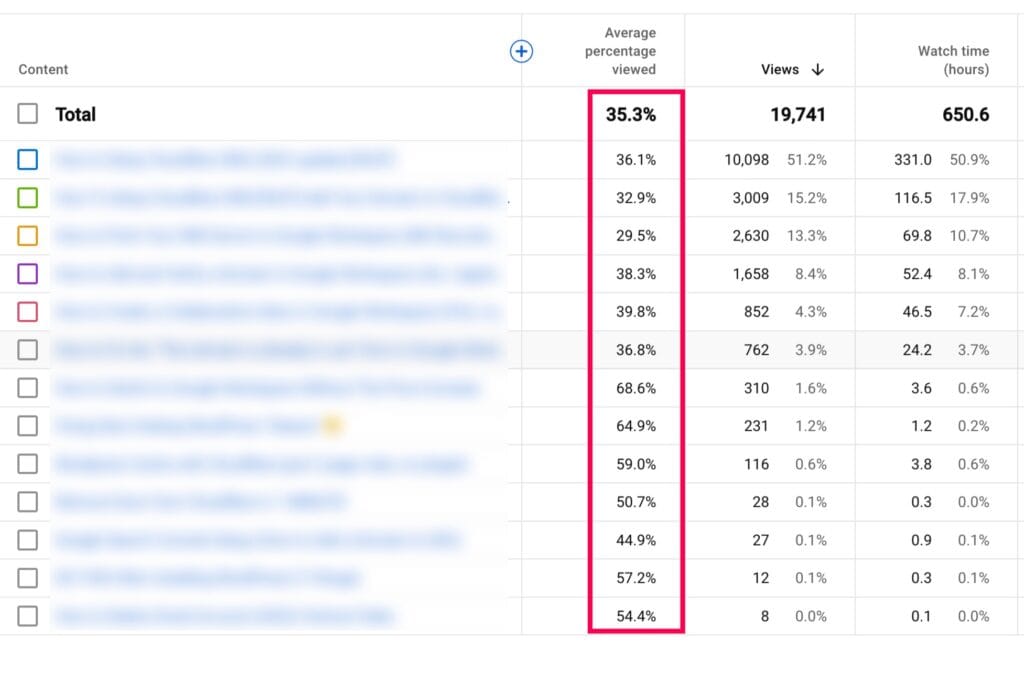
As you can see on the screenshot above, videos never get 100% of audience retention. Actually, 50%+ is a great score (especially for longer videos)!
Now, here is the punchline: YouTube intros always make the audience retention metric drop.
The reason is twofold:
- Viewers who already know your channel skip your intro because they’ve already seen it dozens of times
- Viewers who don’t your channel just want to get to the useful / entertaining bit of your video
So what do viewers do? They skip it.
All it takes is a press of the right arrow key on a computer, or double-tapping the right of the screen on mobile. Boom: intro gone, on to the good stuff.
Because of that, this skipped part of the video doesn’t count towards the time your viewers actually watched your video.
The effect an intro has on audience retention is dramatic. Don’t believe me? Have a look:
Here is an 8-min video without an intro:
As you can see, 68% of viewers are still watching at around the 0:30 mark, “which is typical” says YouTube.
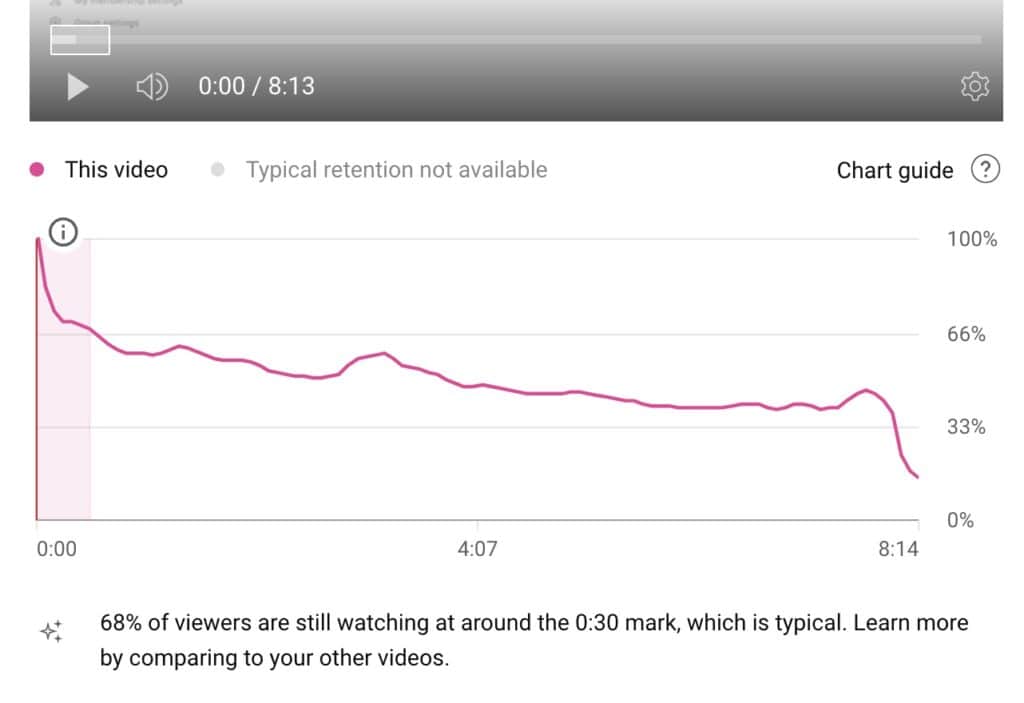
In comparison, here is a 7-min video with an intro.
It’s the same channel and same topic, but an older video with an intro:
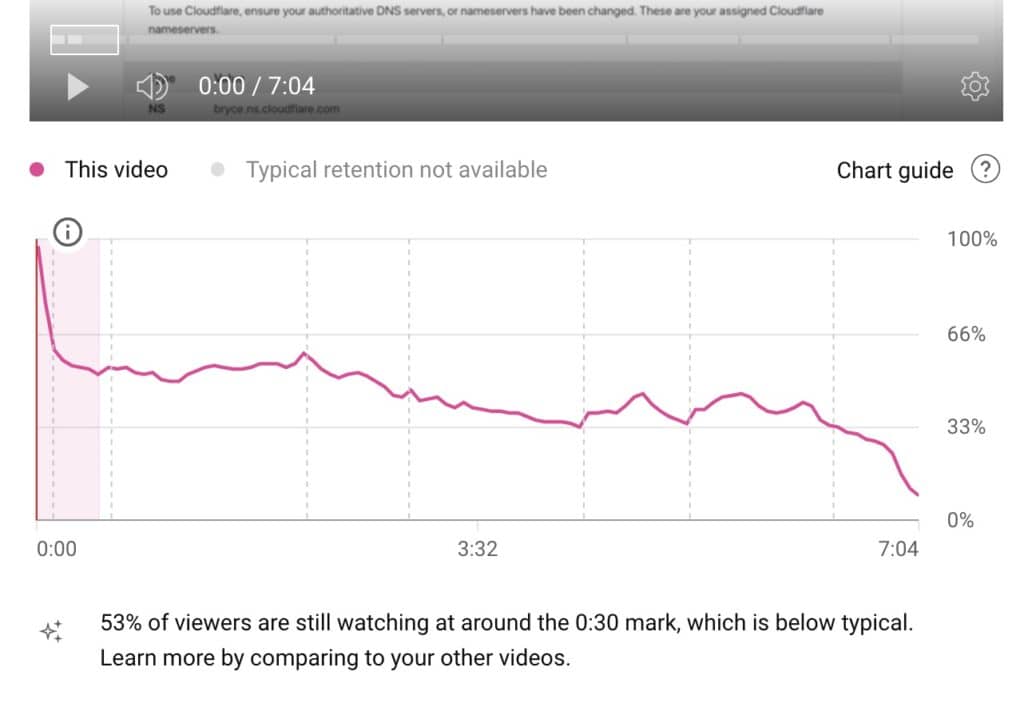
Notice how the drop in audience retention at the beginning of the video is a lot steeper?
That’s because 53% of viewers are still watching at around the 0:30 mark, which is “below typical”. In other words, YouTube is telling you this videos performs worse than other videos in the same topic with the same length.
Now, you’ll always see quite a dramatic in the average percentage viewed at the beginning of every YouTube videos – most people click to see what the video is about, and then leave.
But the difference between the two videos is huge.
The video with the intro has a 22% lower audience retention (1 – 53% / 68%) than the video without an intro. And it’s not just a one-time thing. It’s a consistent trend I’ve seen on every single video I’ve ever uploaded.
People skip the intro and the talking head fluff to go straight to the juicy bit. And YouTube knows it.
That’s why it penalizes videos with intros – it’s not a bug, it’s a feature. It’s a way to make sure that the videos that people actually watch are ranked higher and are more likely to be suggested to viewers.
Now for the terrible part: YouTube’s algorithm is based almost entirely on how your video actually performs. And low audience retention signals YouTube that your video might not be all that enjoyable for viewers after all. As such, YouTube is less likely to feature your video in the browse features, YouTube search or suggested videos.
And you definitely don’t want that, since those 3 traffic sources account for the vast majority of all your channel views.
Aim for a higher audience retention metric. To do so, just don’t place any intro in your videos.
And by the way: while you work on creating an intro, you’re not actually creating useful or entertaining content for viewers to enjoy. You’re basically wasting your time and your viewers’.
Why Hooks Are Better Than Intros
Instead of having a YouTube intro, you should have a hook.
To write a good hook for YouTube, record a short, attention-grabbing segment that:
- is 5-10 seconds long and fast-paced
- is entertaining or useful
- is relevant to the rest of the video
- makes people know what the video is about
- makes people want to watch the rest of the video
Compare this to an intro – an intro wouldn’t check any of these boxes (okay, maybe the first one).
Now, here’s the catch: YouTube clearly states in its Official blog for Creators that the first 15 seconds of your video will impact how it will perform overall. 15 seconds, that’s all you have.
But I would argue that you should make your hook even shorter.
People just need a few seconds to know what your video is about, and to decide if they want to watch it or not. If you can’t do that in 5 seconds, you’re doing something wrong.
Now, not all channels and videos are created equal.
Your video could be about education, reviews, information or entertainment. So let’s break these 4 types of videos down and see what kind of hooks they should have.
Hooks For Educational Videos
For this kind of videos, the hook will be a short summary showing the viewer what they will learn in the video, or by showing them the end result of the video.
For example, if you’re making a video about how to make a cake, your hook could be a short clip of the cake you’re making, or a short clip of the cake you made at the end of the video.
From there, jump right into the video and start teaching the viewer how to make the cake. No fluff, no talking head, no intro.
Hooks For Review Videos
For this kind of videos, the hook could be a small nugget from the entire review.
For example, if you’re making a video about the brand-new iPhone, your hook could be a short clip of the all-new telephoto lens, and the results you got with it, which blows the competition out of the water.
From there, jump right into the video and start reviewing the phone. No fluff, no talking head, no intro.
(Noticed a pattern here?)
Hooks For News / Informational Videos
News reporters know that the best hook is the conclusion or most important part of the article, not the context or the actual story.
So state the conclusion of your video in the hook, and then jump right into the video and start explaining the details of the story.
No fluff, no talking … okay, you get the point.
Hooks For Entertaining Videos
Here, you have basically 2 options:
- Show the “golden moment” of the video, then get back to the beginning of the video and explain how you got there, or
- State “the crazy challenge” of the video, explaining what you’re going to do, which – of course – is uber-epic and entertaining.
MrBeast is a great example of the latter. He probably is the best at hooking viewers with his over-the-top challenges and money giveaways.
I mean, look at this:
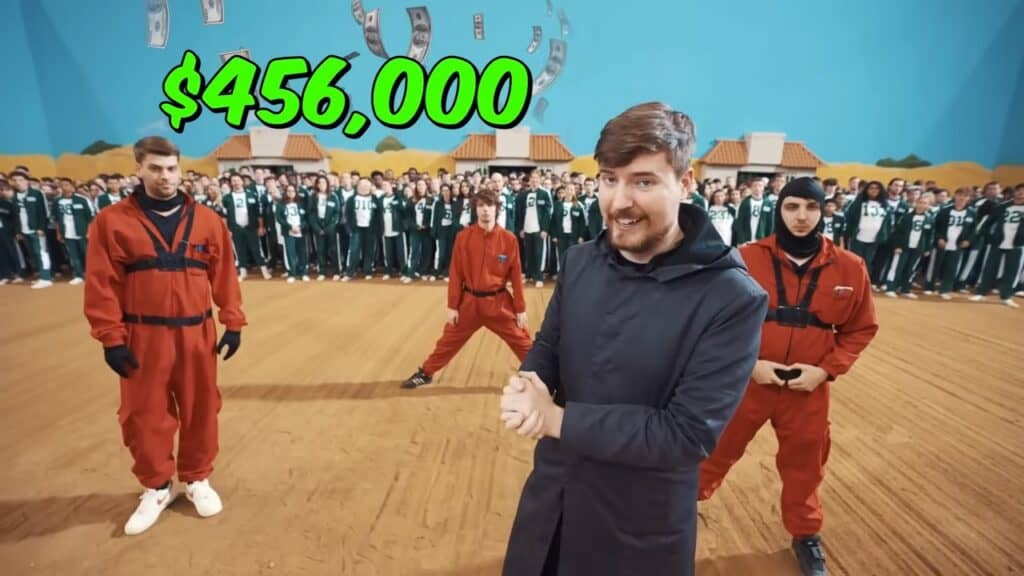
You obviously don’t have to go that far, but keep MrBeast in mind when you’re making your hook.
It should be energetic, with rapid cuts, and it should make people want to watch the rest of the video.
Hooks For Other Types Of Videos
If you’re making a video that doesn’t fit into one of the categories above, you can still use the same principles to make a hook.
Or even better: don’t make a hook at all.
Just start the video with the first interesting part of the video, and let the viewer decide if they want to watch the rest of the video or not.
It’s a lot better than having a boring hook (or worse, a useless intro) that makes people click away.
How to Make a “Good” YouTube Intro
If your boss (or client) forces you to create the “perfect YouTube intro” for their company or product, please send them a link to this article.
But if they still insist, here are some tips to make a short, attention-grabbing intro that will make people less likely to skip the video in its entirety.
1. Make It 5 Seconds Long Or Less
Yes, you read that right. 5 seconds or less.
Actually, the shorter, the better – 5 seconds is the absolute maximum.
But why? Because people are impatient. They don’t want to wait for your intro to finish. They want to get to the good stuff.
The rationale behind this is that:
- The time people reach for their keyboard / screen to skip it, your intro is already done… so they will stick to your content
- Your loyal viewers / subscribers know that it’s short, so they most likely won’t bother skipping such a small part of your video
That’s especially true if the useful bit is right after the intro.
Skipping it might make viewers skip a bit of useful information too! So they’ll probably go back (and never try to skip again on your other videos).
2. Make It Visually Appealing
If all you can think of for your intro is a zoom in on your logo for 5 seconds straight, don’t even bother.
Your intro should be crazy short, not crazy boring!
Make it lively with different images or clips, cuts, music, sound FX… Make people actually want to watch it again! Or at least, make it bearable over the 5 seconds it lasts.
Again, if you can’t do that, just forget about making an intro altogether.
3. Make It Count
An intro should not be some kind of idle time.
Use it as a reminder of what your channel is all about, and what the value for the viewer is. Typically, you might want to place it *after* your hook, if you have one.
Just a note: if your company or channel needs more than 5 seconds to convey what it’s all about, then you have another problem: branding or mission. You might have to rethink your brand altogether and get mission statement and value proposition right before uploading your first video.
Branding is the most important aspect of what you do. And it has nothing to do with a logo or a slogan.
So always make sure that your branding is on point before you start making videos.
A Great Example Of A Short, Attention-grabbing Intro
The Video Creators channel does it right.
Have a look:
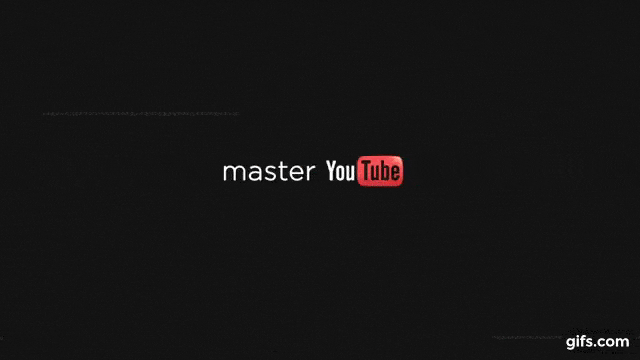
Video Creator’s intro has it all.
- It lasts only 3 seconds – you don’t even have time to think about skipping it
- It’s visually appealing – thanks to the glitches and sound effects over the channel name
- It states the value proposition of the channel clearly
You check out their intro live in this video (from 0:37 to 0:40).
(By the way, notice how the intro is placed after the hook? That’s because the hook is the most important part of the video, and the intro is just a reminder of what the channel is about.)
Aim to replicate the same kind of intro… if you absolutely need one.
Wrapping Up
In conclusion, YouTube intros are not necessary and can actually hurt your audience retention.
Instead of using an intro, focus on creating content that is engaging and provides value or entertainment to the viewers. This way, you’ll be able to keep your viewers around for longer periods of time.
Investing in quality content is always a better option than wasting time on creating a useless intro.
Be strong, you got this!

